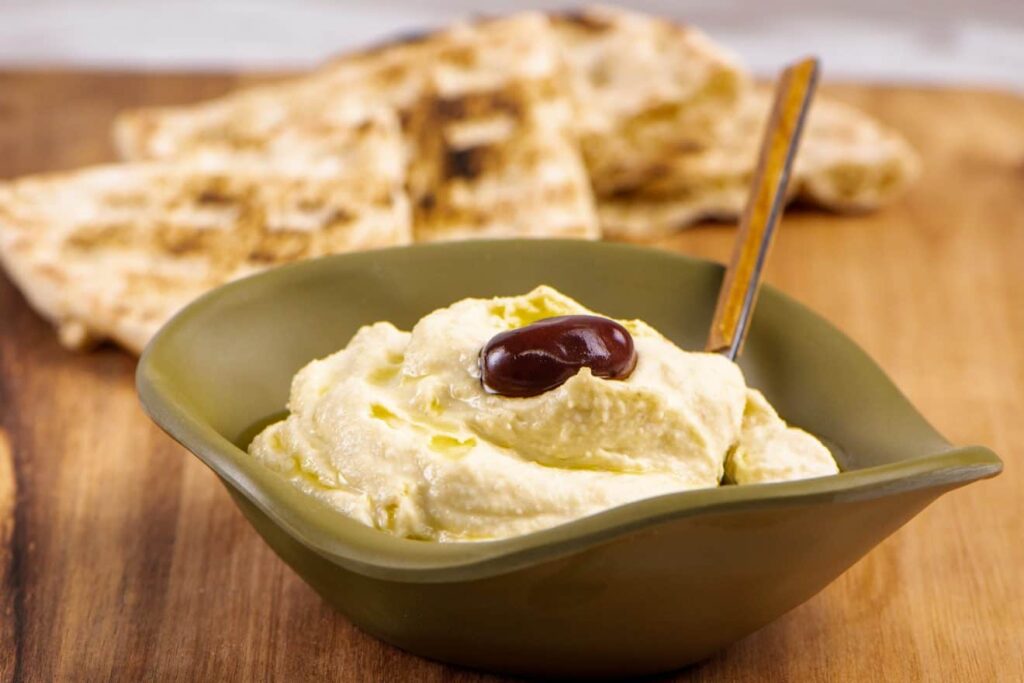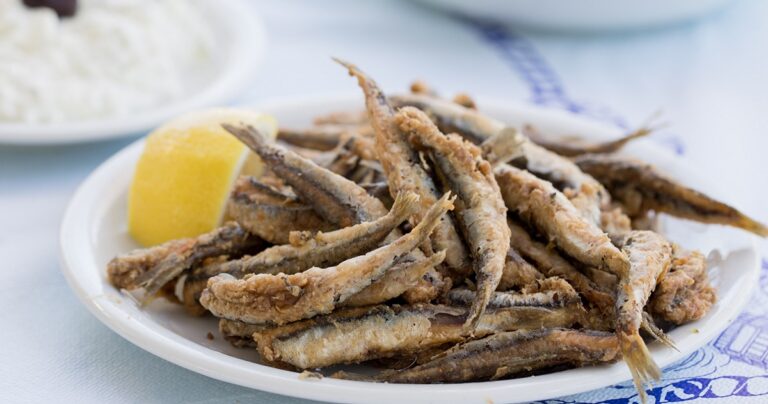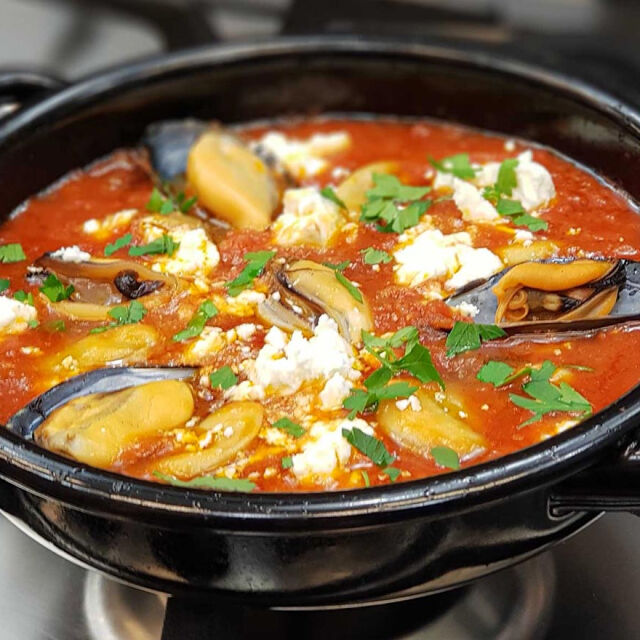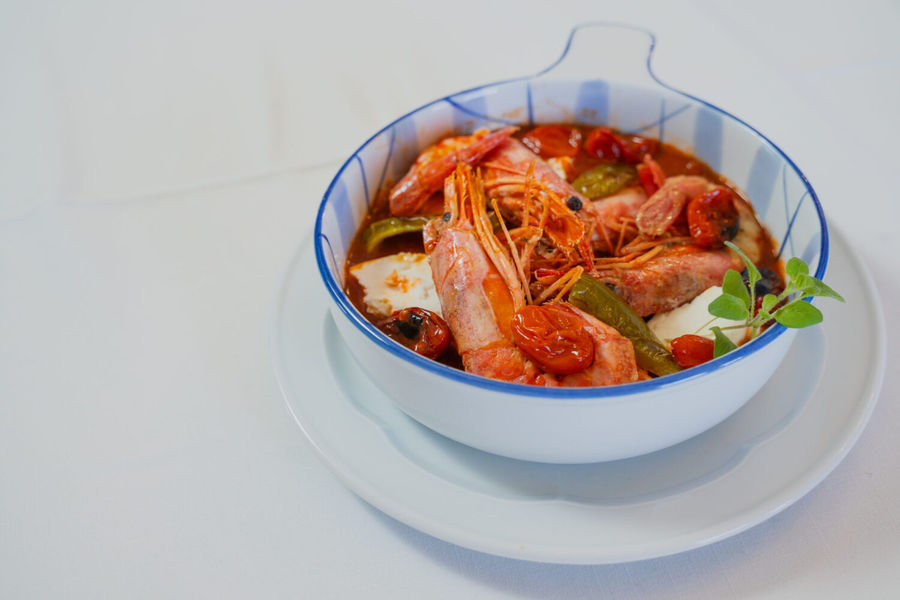Introduction: The Sea as a Greek Kitchen
In Greece, the sea has always been both a provider and a teacher. Stretching across thousands of islands and peninsulas, especially the Greek islands, the coastline offers a bounty of seafood that has profoundly influenced local culinary traditions and the abundance of fresh fish in island cuisine. Fish and seafood are not just ingredients; they are an integral part of Greece’s identity, woven into its myths, daily life, and celebrations, and form a cornerstone of the Greek diet, reflecting traditional eating habits and the healthful Mediterranean way of life. From humble fishing villages to fine urban tavernas, seafood reflects the Greek philosophy of simplicity and respect for nature.
Ancient Origins of Greek Seafood Cuisine
Greek seafood traditions trace back to antiquity. Archaeological finds indicate that ancient Greeks consumed a diverse range of seafood, including squid, octopus, anchovies, and mullet. In classical literature, seafood appears in Homer’s Odyssey and in Aristophanes’ comedies, where fish markets were lively social centres. The Greeks learned to preserve fish through salting, drying, and fermenting — methods that continue to define coastal cuisine today.
Ancient methods, such as salting bonito or mullet roe (the ancestor of modern avgotaracho), were both practical and luxurious. These preserved delicacies allowed Greeks to savour the sea even during harsh winters or long voyages. The continuity of these traditions is what makes Greek seafood culture so distinctive — it’s both ancient and alive.
Geography and Diversity: A Nation of Many Seas
Each region of Greece expresses its connection to the sea in different ways.
- The Aegean islands favour grilled and charred fish, often served with capers and herbs.
- The Ionian coast, influenced by Italy, features rich stews and risottos.
- The Peloponnese is known for its salt-preserved fish and roe delicacies, particularly in Messolonghi, the home of avgotaracho (Greek bottarga).
- In Crete, seafood is often cooked with olive oil, wild greens, and barley rusks — a combination that is austere yet intensely flavorful.
This geographic variety creates a vibrant mosaic of tastes that reflect Greece’s deep connection to both land and sea. Across these regions, Greek cuisine offers more fish than many expect, with an impressive diversity of species and preparations that showcase the abundance found in local waters.
Key Ingredients and Techniques
Greek seafood cooking depends on freshness, restraint, and purity.
- Olive oil is the foundation, lending body and depth.
- Lemon provides brightness.
- Oregano, thyme, garlic, and parsley offer balance and fragrance.
- Vinegar and wine add gentle acidity, key in marinades and sauces.
Grilling, frying, baking in parchment, marinating, and cooking are all traditional cooking techniques. The goal is always to highlight the fish itself — never to mask it. Whether it’s a simple grilled sardine or a refined slice of avgotaracho, the principle remains the same: let the sea speak for itself.
Thinly sliced and sliced onions are commonly used in Greek seafood dishes for optimal flavour and texture. Tomato sauce is also a key component in baked or stewed seafood dishes, adding rich flavour and depth.
From the Fisherman to the Table
The journey of seafood in Greece is deeply rooted in local traditions. Many tavernas still buy directly from fishermen at dawn, serving the catch of the day by lunchtime—markets in Piraeus, Thessaloniki, and Heraklion brim with glistening sardines, squid, and octopus, where the freshest fish are easily recognised by their bright red gills or flesh, a sure sign of quality. Fresh cod and fresh sardines are especially prized catches in these Greek seafood markets, celebrated for their flavour and authenticity.
Sustainability is not a modern trend here — it’s an inherited ethic. Greek fishermen traditionally avoid overfishing, respecting seasonal rhythms and coastal ecosystems.
The Greek Table: Simplicity and Sharing
To eat seafood in Greece is to share — not just food, but time, laughter, and presence. Meals are communal, never rushed. Even the humblest seaside taverna offers an experience rich in ritual: the clink of ouzo glasses, the scent of grilled fish, the rhythm of waves against the shore. Gathering for a traditional Greek fish dinner with family and friends is a cherished custom that celebrates the abundance of fresh seafood and the joy of togetherness. The dishes are small and varied, meant to be shared — an approach embodied in the art of the meze, where a popular dish like prawn pilaf or shrimp saganaki often takes centre stage at Greek tables.
The Essence of Fish Meze
The Greek meze is more than a meal; it’s a philosophy of eating. The term psaromezedes (fish meze) refers to small seafood dishes designed for leisurely enjoyment with ouzo, tsipouro, or white wine. It’s a practice that encourages tasting, conversation, and connection — each dish offering a different sensory experience. Many seafood recipes, featuring fresh fish, shellfish, and other delicacies, form the backbone of this tradition, showcasing the diversity of Greek maritime cuisine.
Fish meze can range from tiny, marinated anchovies (gavros marinatos) to grilled octopus, salted mackerel, or fried smelt. Some are served hot, others chilled or pickled. The guiding principle is contrast — tangy against rich, salty against sweet, firm against tender. These meze are prepared using a variety of recipes, from traditional family methods to modern interpretations. The result is a harmonious mosaic of flavours that evokes the Aegean itself.
Classic Greek Fish Meze Dishes
1. Gavros Marinatos (Marinated Anchovies)

Fresh anchovies, filleted and marinated in a blend of vinegar, olive oil, garlic, and herbs. Served cold, they are a crisp, tangy companion to ouzo.
2. Lakerda (Cured Bonito)

An ancient delicacy made by salting bonito fillets for days, then storing them in olive oil. Sliced thin and served with lemon and onions, lakerda embodies Greece’s love for intense, preserved flavours.
3. Taramosalata (Fish Roe Dip)

Made from cured cod or mullet roe (tarama), olive oil, lemon, and bread, this smooth, briny dip is a meze classic. Its luxurious texture bridges humble ingredients and refined taste.
4. Psaraki Tiganito (Fried Small Fish)

Tiny fish, such as smelt or whitebait, are lightly floured and fried to a crisp golden brown. Eaten whole, they capture the essence of Greek summer simplicity.
5. Chtapodi Xidato (Octopus in Vinegar)

Tender octopus marinated in a blend of vinegar and herbs. Served cold, it’s tangy, aromatic, and ideal for fasting seasons.
6. Mydia Saganaki (Mussels with Tomato and Feta)

Mussels simmered with tomato, garlic, and feta — a dish that captures both sea and land in a single bite.
These dishes form the backbone of the psaromezedes tradition — modest yet deeply expressive, inviting endless combinations of taste and texture.
9. Avgotaracho: The Jewel of Greek Seafood

Among all fish meze, one stands out as a treasure — avgotaracho (Greek bottarga), the salted and waxed roe of the grey mullet. This delicacy, produced primarily in the lagoons of Messolonghi in western Greece, is considered the pinnacle of Greek seafood craftsmanship. Known since antiquity, both Byzantine traders and Venetian nobles praised it.
The roe sacs are gently salted, air-dried, and then sealed in natural beeswax — a method that protects their aroma while enhancing their complexity. The result is an amber-gold delicacy with a flavour both marine and nutty, briny and slightly sweet. Officially protected under EU law as Avgotaracho Messolonghiou (PDO), it is one of Greece’s most prized exports.
Greek Seafood Soups and Stews
Greek seafood soups and stews are a cornerstone of the country’s culinary tradition, offering a comforting embrace of the sea in every spoonful. These classic Greek dishes bring together the freshest seafood—firm white fish, succulent shellfish, and sometimes even octopus or squid—with aromatic onions, garlic, and a generous drizzle of olive oil. The result is a medley of flavours that is both hearty and refined, perfect for seafood lovers seeking an authentic taste of Greece.
One of the most beloved examples is Psarosoupa, a robust fish soup that captures the essence of the Greek sea. Made with a variety of fresh seafood simmered alongside vegetables and fresh herbs, Psarosoupa is known for its flavorful broth, often brightened with a squeeze of fresh lemon juice. Traditionally served with crusty bread or ladled over rice, this dish invites diners to soak up every drop of its delicious, savoury sauce.
Equally iconic is Kakavia, the fisherman’s stew that has nourished generations along the Greek coast. This simple recipe calls for whatever the day’s catch provides—sea bass, red snapper, or other favourite fish—slow-cooked with onions, garlic, and a splash of white wine. The stew is finished with fresh herbs and a drizzle of olive oil, creating a flavorful sauce that begs to be mopped up with rustic bread. Kakavia is a celebration of whole foods and the Mediterranean diet, where the quality of the ingredients shines through in every bite.
Beyond these classics, Greek cuisine offers a variety of seafood stews and soups, each with its own regional twist. Some feature fresh tomatoes and crumbled feta cheese for a tangy, creamy finish, while others highlight the natural sweetness of shellfish or the briny depth of the Aegean Sea. Whether you prefer a light, lemony broth or a rich, tomato-based stew, there is a Greek seafood recipe to suit every palate.
To bring these traditional dishes to your own table, start with the freshest seafood you can find, high-quality olive oil, and plenty of fresh herbs. A dash of black pepper, a squeeze of lemon, and a sprinkle of crumbled feta cheese can elevate the flavours even further. Serve your soup or stew with lemon wedges and slices of crusty bread, and enjoy a meal that is as nourishing as it is delicious.
Greek seafood soups and stews are more than just main dishes—they are a testament to the Greek way of cooking: simple, seasonal, and always centred around the bounty of the sea. Whether enjoyed on a cool evening or as part of a festive gathering, these dishes are sure to become favourites for anyone who loves Mediterranean flavours.
Serving and Pairing
Traditionally, avgotaracho is sliced thin and drizzled with olive oil and lemon. It is paired beautifully with dakos (Cretan barley rusks), crusty bread, or chilled white wine. Modern chefs grate it over pasta or seafood risotto, but in Greece, it remains a pure celebration of the sea.
Avgotaracho represents the refined side of Greek seafood — an expression of patience, precision, and respect for the natural world. It reminds diners that luxury can be simple when guided by tradition and care.
The Ritual of the Greek Table
In every mezedopoleio — the small taverns that serve meze — dining is a communal act. The plates arrive gradually, encouraging conversation and slowing the passage of time. Each dish plays a role in the rhythm of the meal: marinated fish awakens the palate, grilled or fried fish satisfies, and something rare like avgotaracho crowns the experience.
Drinks accompany the food, not the other way around. Ouzo’s anise notes enhance salty fish, tsipouro balances intense flavours like cured mackerel, and crisp wines cut through the richness of roe and olive oil. This balance — between drink, food, and company — is the heart of the Greek table.
A Philosophy of Sustainability
Greek seafood cuisine, shaped by geography and necessity, offers timeless lessons in sustainability. Small-scale fishing, seasonal respect, and minimal waste were once practicalities; today, they are ecological ideals. Ancient preservation techniques, such as salting and drying, were early forms of resourcefulness that ensured nothing from the catch went to waste.
In modern Greece, these principles remain in effect. Families still eat what the sea provides that day, choosing smaller, more abundant fish rather than overharvested species. Taverns proudly serve catch of the day, not imported staples. Sustainability, in Greek tradition, is not a trend — it is the natural outcome of living with the sea rather than against it.
Conclusion: The Living Legacy of the Greek Sea
Greek seafood serves as a living bridge between the past and present, where taste, tradition, and sustainability coexist in perfect harmony. From the simple joy of shared fish meze to the quiet luxury of avgotaracho, every dish tells a story — of fishermen and artisans, of patience and pride, of a culture that listens to the rhythm of the waves. To eat from the Greek sea is to taste its history and its harmony — a celebration of simplicity transformed into timeless art.




